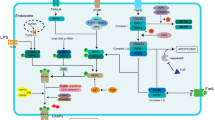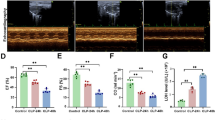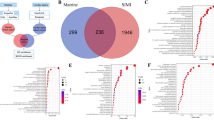Abstract
The molecular mechanisms of acute lung injury (ALI) are closely associated with nucleotide-binding domains and leucine-rich repeat (NLR) pyrin domains containing 3 (NLRP3) inflammasome, in which alveolar macrophages (AMs) exert an essential function. Our study has been proved that artesunate (AS) inhibits ALI. Nevertheless, the inhibition actions of AS on activation of NLRP3 in renal ischemia-reperfusion (RIR)-mediated ALI remain to be further discussed. Male Sprague-Dawley rats were randomly assigned into four groups: sham + NS, sham + AS, RIR + NS, and RIR + AS. RIR-mediated ALI was performed through bilateral renal pedicle occlusion for 60 min followed by reperfusion for 24 h. AS (15 mg/kg) or NS was injected intraperitoneal to rat 1 h before RIR treatment. AMs were rendered hypoxic (0.5%) for 2 h and reoxygenated for 24 h. Lung injury index and histology, and inflammatory cells and cytokine release in the BALF and AMs were examined. The protein and mRNA levels of NLRP3, ASC, and caspase-1 in the lung and AMs were evaluated via Western blot and real-time RCR. In this research, we indicated that AS preconditioning inhibited RIR-mediated lung damage, vascular permeability, and edema in rats. AS reduced RIR-mediated ALI, as characterized by abatement in the count of inflammatory cells, and the production of inflammatory cytokines in the BALF. AS administration inhibited the number of F4/80-positive cells, the activity of myeloperoxidase, and the fiery cytokines mRNA expression in lung samples of RIR-stimulated rats. Furthermore, AS alleviated the activity of caspase-1 and activation of NLRP3 through depending on reactive oxygen species (ROS). An in vitro finding that AS mitigated hypoxia/reoxygenation-mediated activation of AMs partially supported in vivo study. In a word, these findings demonstrate that AS pretreatment attenuated RIR-mediated ALI potentially through reducing ROS-induced activation of the NLRP3 inflammasome.







Similar content being viewed by others
References
Mokra, D., and P. Kosutova. 2015. Biomarkers in acute lung injury. Respiratory Physiology & Neurobiology 209: 52–58.
Impellizzeri, D., G. Bruschetta, E. Esposito, and S. Cuzzocrea. 2015. Emerging drugs for acute lung injury. Expert Opinion on Emerging Drugs 20: 75–89.
Butt, Y., A. Kurdowska, and T.C. Allen. 2016. Acute lung injury: a clinical and molecular review. Archives of Pathology & Laboratory Medicine 140: 345–350.
He, Y., H. Hara, and G. Nunez. 2016. Mechanism and regulation of NLRP3 Inflammasome activation. Trends in Biochemical Sciences 41: 1012–1021.
Abais, J.M., M. Xia, Y. Zhang, K.M. Boini, and P.L. Li. 2015. Redox regulation of NLRP3 inflammasomes: ROS as trigger or effector? Antioxidants & Redox Signaling 22: 1111–1129.
Grailer, J.J., B.A. Canning, M. Kalbitz, M.D. Haggadone, R.M. Dhond, A.V. Andjelkovic, F.S. Zetoune, and P.A. Ward. 2014. Critical role for the NLRP3 inflammasome during acute lung injury. Journal of Immunology 192: 5974–5983.
De Nardo, D., C.M. De Nardo, and E. Latz. 2014. New insights into mechanisms controlling the NLRP3 inflammasome and its role in lung disease. The American Journal of Pathology 184: 42–54.
Altmann, C., A. Andres-Hernando, R.H. McMahan, N. Ahuja, Z. He, C.J. Rivard, C.L. Edelstein, L. Barthel, W.J. Janssen, and S. Faubel. 2012. Macrophages mediate lung inflammation in a mouse model of ischemic acute kidney injury. American Journal of Physiology. Renal Physiology 302: F421–F432.
Xu, Y., C. Meng, G. Liu, D. Yang, L. Fu, M. Zhang, Z. Zhang, H. Xia, S. Yao, and S. Zhang. 2016. Classically activated macrophages protect against lipopolysaccharide-induced acute lung injury by expressing amphiregulin in mice. Anesthesiology 124: 1086–1099.
Wu, J., Z. Yan, D.E. Schwartz, J. Yu, A.B. Malik, and G. Hu. 2013. Activation of the NLRP3 inflammasome in alveolar macrophages contributes to mechanical stretch-induced lung inflammation and injury. Journal of Immunology 190: 3590–3599.
Cao, T.H., S.G. Jin, D.S. Fei, K. Kang, L. Jiang, Z.Y. Lian, S.H. Pan, M.R. Zhao, and M.Y. Zhao. 2016. Artesunate protects against sepsis-induced lung injury via heme oxygenase-1 modulation. Inflammation 39: 651–662.
Zhao, D., J. Zhang, G. Xu, and Q. Wang. 2017. Artesunate protects LPS-induced acute lung injury by inhibiting TLR4 expression and inducing Nrf2 activation. Inflammation 40: 798–805.
Liu, Z., J. Zhang, S. Li, and J. Jiang. 2018. Artesunate inhibits renal ischemia reperfusion-stimulated lung inflammation in rats by activating HO-1 pathway. Inflammation 41: 114–121.
Wan, R.J., and Y.H. Li. 2017. Effects of artesunate prevent nephritis via the Toll-like receptor 4/nuclear factor kappaB signaling pathway in rats. Molecular Medicine Reports 16: 6389–6395.
Zuo, S., H. Ge, Q. Li, X. Zhang, R. Hu, S. Hu, X. Liu, J.H. Zhang, Y. Chen, and H. Feng. 2017. Artesunate protected blood-brain barrier via sphingosine 1 phosphate receptor 1/phosphatidylinositol 3 kinase pathway after subarachnoid hemorrhage in rats. Molecular Neurobiology 54: 1213–1228.
Lai, L., Y. Chen, X. Tian, X. Li, X. Zhang, J. Lei, Y. Bi, B. Fang, and X. Song. 2015. Artesunate alleviates hepatic fibrosis induced by multiple pathogenic factors and inflammation through the inhibition of LPS/TLR4/NF-kappaB signaling pathway in rats. European Journal of Pharmacology 765: 234–241.
Ng, D.S., W. Liao, W.S. Tan, T.K. Chan, X.Y. Loh, and W.S. Wong. 2014. Anti-malarial drug artesunate protects against cigarette smoke-induced lung injury in mice. Phytomedicine 21: 1638–1644.
Naidu, B.V., B. Krishnadasan, K. Byrne, A.L. Farr, M. Rosengart, E.D. Verrier, and M.S. Mulligan. 2002. Regulation of chemokine expression by cyclosporine A in alveolar macrophages exposed to hypoxia and reoxygenation. The Annals of Thoracic Surgery 74: 899–905 discussion.
Phelan, P., H.E. Merry, B. Hwang, and M.S. Mulligan. 2015. Differential toll-like receptor activation in lung ischemia-reperfusion injury. The Journal of Thoracic and Cardiovascular Surgery 149: 1653–1661.
Sharma, A.K., D.P. Mulloy, L.T. Le, and V.E. Laubach. 2014. NADPH oxidase mediates synergistic effects of IL-17 and TNF-alpha on CXCL1 expression by epithelial cells after lung ischemia-reperfusion. American Journal of Physiology. Lung Cellular and Molecular Physiology 306: L69–L79.
Park, K.H., Y.D. Yoon, S.B. Han, S.J. Oh, J. Yun, C.W. Lee, K. Lee, S.K. Park, H.M. Kim, and J.S. Kang. 2012. Artemisinin inhibits lipopolysaccharide-induced interferon-beta production in RAW 264.7 cells: implications on signal transducer and activator of transcription-1 signaling and nitric oxide production. International Immunopharmacology 14: 580–584.
Zhou, L., D. Zhao, H. An, H. Zhang, C. Jiang, and B. Yang. 2015. Melatonin prevents lung injury induced by hepatic ischemia-reperfusion through anti-inflammatory and anti-apoptosis effects. International Immunopharmacology 29: 462–467.
Uchiyama, M., K. Tojo, T. Yazawa, S. Ota, T. Goto, and K. Kurahashi. 2015. Edaravone prevents lung injury induced by hepatic ischemia-reperfusion. The Journal of Surgical Research 194: 551–557.
Hoshino, T., M. Okamoto, Y. Sakazaki, S. Kato, H.A. Young, and H. Aizawa. 2009. Role of proinflammatory cytokines IL-18 and IL-1beta in bleomycin-induced lung injury in humans and mice. American Journal of Respiratory Cell and Molecular Biology 41: 661–670.
Piper, S.C., J. Ferguson, L. Kay, L.C. Parker, I. Sabroe, M.A. Sleeman, E. Briend, and D.K. Finch. 2013. The role of interleukin-1 and interleukin-18 in pro-inflammatory and anti-viral responses to rhinovirus in primary bronchial epithelial cells. PLoS One 8: e63365.
Sekine, K., S. Fujishima, J. Sasaki, A. Ishizaka, S. Aiso, and N. Aikawa. 2009. In vivo IL-18 supplementation ameliorates lethal acute lung injury in burn-primed endotoxemic mice: a novel anti-inflammatory role of IL-18. Shock 32: 554–562.
Luo, Y.P., L. Jiang, K. Kang, D.S. Fei, X.L. Meng, C.C. Nan, S.H. Pan, M.R. Zhao, and M.Y. Zhao. 2014. Hemin inhibits NLRP3 inflammasome activation in sepsis-induced acute lung injury, involving heme oxygenase-1. International Immunopharmacology 20: 24–32.
Zhang, Y., X. Li, J.J. Grailer, N. Wang, M. Wang, J. Yao, R. Zhong, G.F. Gao, P.A. Ward, and D.X. Tan. 2016. Melatonin alleviates acute lung injury through inhibiting the NLRP3 inflammasome. Journal of Pineal Research 60: 405–414.
Han, S., W. Cai, X. Yang, Y. Jia, Z. Zheng, H. Wang, J. Li, Y. Li, J. Gao, L. Fan, and D. Hu. 2015. ROS-mediated NLRP3 Inflammasome activity is essential for burn-induced acute lung injury. Mediators of Inflammation 2015: 720457.
Kim, S.R., D.I. Kim, S.H. Kim, H. Lee, K.S. Lee, S.H. Cho, and Y.C. Lee. 2014. NLRP3 inflammasome activation by mitochondrial ROS in bronchial epithelial cells is required for allergic inflammation. Cell Death & Disease 5: e1498.
Oh, J.Y., J.H. Ko, H.J. Lee, J.M. Yu, H. Choi, M.K. Kim, W.R. Wee, and D.J. Prockop. 2014. Mesenchymal stem/stromal cells inhibit the NLRP3 inflammasome by decreasing mitochondrial reactive oxygen species. Stem Cells 32: 1553–1563.
Author information
Authors and Affiliations
Contributions
Zhaohui Liu wrote the main manuscript text and prepared all figures. Min Qu and Zhaohui Liu performed the animal model and collected the samples. Lili Yu, Panpan Song, and Yulin Chang helped to revise the manuscript. Min Qu and Zhaohui Liu conceived the study and revised the manuscript. Min Qu and Zhaohui Liu provided the funding support. All authors reviewed the manuscript. All authors read and approved the final manuscript.
Corresponding author
Ethics declarations
All procedures were performed in accordance with the Declaration of Helsinki of the World Medical Association. The study was approved by the ethics committee of Cangzhou Central Hospital, Cangzhou, Hebei, China.
Conflict of Interest
The authors declare that they have no conflict of interest.
Rights and permissions
About this article
Cite this article
Liu, Z., Qu, M., Yu, L. et al. Artesunate Inhibits Renal Ischemia-Reperfusion-Mediated Remote Lung Inflammation Through Attenuating ROS-Induced Activation of NLRP3 Inflammasome. Inflammation 41, 1546–1556 (2018). https://doi.org/10.1007/s10753-018-0801-z
Published:
Issue Date:
DOI: https://doi.org/10.1007/s10753-018-0801-z




